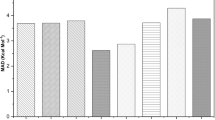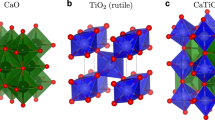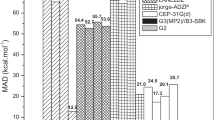Abstract
Enthalpies of formation of twenty-nine compounds of aluminium were calculated employing various density functional theory (DFT) (B3LYP, B2PLYP, LC-wPBE, PBE1PBE, BMK, M06 and M06-2X) and composite methods (EnAt1, EnAt2, G3X-CEP, G3X(CCSD)-CEP and G4), using atomization. The best agreement with experimental data was achieved by using Gn and Gn-CEP multilevel techniques. It was found that the best performance among DFT methods within the atomization approach demonstrated the long range corrected M06-2X level theory. The mean absolute error calculated for EnAt1 and EnAt2, which has recently been reported as a very accurate method for calculating enthalpies of formation, for 248 compounds from the G3/05 test set presented the best results when compared with functional DFT.
Similar content being viewed by others
References
Groent CP, Oskam A, Kovács A (2003) Theoretical study of mixed MLaX4 (M = Na, K, Cs; X = F, Cl, Br, I) rare earth/alkali metal halide complexes. Inorg Chem 42:851–858. https://doi.org/10.1021/ic0260973
Laghrissi A, Salmani EM, Dehmani M et al (2016) Ab initio calculations of exchange interactions, Magnetic and optical properties of (Cu, TM)AlO2 (TM: Ti, V, Cr, Mn and Fe,): LDA and SIC approximation. Optik (Stuttg) 127:6991–6996. https://doi.org/10.1016/j.ijleo.2016.05.024
Yang J, Liang F, Cheng Y et al (2019) Improvement of dehydrogenation performance by adding CeO2 to α-AlH3. Int J Hydrog Energy. https://doi.org/10.1016/j.ijhydene.2019.11.086
Luo Z, Lei W, Wang X et al (2020) AlF3 coating as sulfur immobilizers in cathode material for high performance lithium-sulfur batteries. J Alloys Compd 812:152132. https://doi.org/10.1016/j.jallcom.2019.152132
Wu H, Chen L, Zhu F et al (2020) The dynamic development of bacterial community following long-term weathering of bauxite residue. J Environ Sci (China) 90:321–330. https://doi.org/10.1016/j.jes.2019.12.001
Shunmugasundaram M, Praveen Kumar A, Ponraj Sankar L, Sivasankar S (2020) Experimental investigation and process parameters optimization of stir cast aluminium metal matrix composites to improve material removal rate. Mater Today Proc. https://doi.org/10.1016/j.matpr.2020.01.128
Zhang CQ, Liu W (2019) Non-parabolic Al3Ti intermetallic layer growth on aluminum-titanium interface at low annealing temperatures. Mater Lett 256:126624. https://doi.org/10.1016/j.matlet.2019.126624
Kumar Chauhan P, Khan S (2019) Microstructural examination of aluminium-copper functionally graded material developed by powder metallurgy route. Mater Today Proc. https://doi.org/10.1016/j.matpr.2019.10.007
Carey WC, Dixon DG, McDonnell JAM (1985) Space shuttle microabrasion foil experiment (MFE): implications for aluminium oxide sphere contamination of near-earth space. Adv Sp Res 5:87–90. https://doi.org/10.1016/0273-1177(85)90390-4
Wu C, Wang B, Wu N et al (2020) Molecular-scale understanding on the structure evolution from melamine diborate supramolecule to boron nitride fibers. Ceram Int 46:1083–1090. https://doi.org/10.1016/j.ceramint.2019.09.075
Curtiss LA, Redfern PC, Raghavachari K (2005) Assessment of Gaussian-3 and density-functional theories on the G3/05 test set of experimental energies. J Chem Phys. https://doi.org/10.1063/1.2039080
Curtiss LA, Redfern PC, Raghavachari K (2007) Gaussian-4 theory. J Chem Phys. https://doi.org/10.1063/1.2436888
Pereira DH, Ramos AF, Morgon NH, Custodio R (2011) Implementation of pseudopotential in the G3 theory for molecules containing first-, second-, and non-transition third-row atoms. J Chem Phys. https://doi.org/10.1063/1.3609241
Pereira DH, Ramos AF, Morgon NH, Custodio R (2013) Erratum: “Implementation of pseudopotential in the G3 theory for molecules containing first-, second-, and non-transition third-row atoms” [J. Chem. Phys. 135, 034106 (2011)]. J Chem Phys 135:219901. https://doi.org/10.1063/1.3666235
Stevens WJ, Basch H, Krauss M (1984) Compact effective potentials and efficient shared-exponent basis sets for the first- and second-row atoms. J Chem Phys 81:6026–6033. https://doi.org/10.1063/1.447604
Rocha CMR, Pereira DH, Morgon NH, Custodio R (2013) Assessment of G3(MP2)//B3 theory including a pseudopotential for molecules containing first-, second-, and third-row representative elements. J Chem Phys 139:1–13. https://doi.org/10.1063/1.4826519
Pereira DH, Rocha CMR, Morgon NH, Custodio R (2015) G3(MP2)-CEP theory and applications for compounds containing atoms from representative first, second and third row elements of the periodic table. J Mol Model 21:204. https://doi.org/10.1007/s00894-015-2757-3
Silva CDS, Pereira DH, Custodio R (2016) G4CEP: a G4 theory modification by including pseudopotential for molecules containing first-, second- and third-row representative elements. J Chem Phys. https://doi.org/10.1063/1.4952427
Leal RC, Custodio R (2019) G3(MP2)//B3-SBK: a revision of a composite theory for calculations of thermochemical properties including some non-transition elements beyond the fourth period. Comput Theor Chem 1149:1–7. https://doi.org/10.1016/j.comptc.2018.12.016
Silva CS, Custodio R (2018) Empirical corrections in the G3X and G3X(CCSD) theories combined with a compact effective pseudopotential. Theor Chem Acc. https://doi.org/10.1007/s00214-018-2206-3
Silva CS, Custodio R (2015) Investigation of the pseudopotential Stuttgart/Dresden in the G3(MP2,CSSD,rel) theory for compounds containg transition elements. Rev Process Químicos 9:66–67. https://doi.org/10.19142/rpq.v9i18.258
De Souza Silva C, Custodio R (2019) Assessment of pKa determination for monocarboxylic acids with an accurate theoretical composite method: G4CEP. J Phys Chem A. https://doi.org/10.1021/acs.jpca.9b05380
Nelder JA, Mead R (1965) A simplex method for function minimization. Comput J 7:308–313. https://doi.org/10.1093/comjnl/7.4.308
Becke AD (1988) Density-functional exchange-energy approximation with correct asymptotic behavior. Phys Rev A 38:3098–3100. https://doi.org/10.1103/PhysRevA.38.3098
Lee C, Yang WT, Parr RG (1988) Development of the Colle-Salvetti correlation-energy formula into a functional of the electron density. Phys Rev B 37:785–789. https://doi.org/10.1103/PhysRevB.37.785
Grimme S (2006) Semiempirical hybrid density functional with perturbative second-order correlation. J Chem Phys 124:034108. https://doi.org/10.1063/1.2148954
Boese AD, Martin JML (2004) Development of density functionals for thermochemical kinetics. J Chem Phys 121:3405–3416. https://doi.org/10.1063/1.1774975
Zhao Y, Truhlar DG (2008) The M06 suite of density functionals for main group thermochemistry, thermochemical kinetics, noncovalent interactions, excited states, and transition elements: two new functionals and systematic testing of four M06-class functionals and 12 other function. Theor Chem Acc 120:215–241. https://doi.org/10.1007/s00214-007-0310-x
Heyd J, Scuseria GE, Ernzerhof M (2003) Hybrid functionals based on a screened Coulomb potential. J Chem Phys 118:8207–8215. https://doi.org/10.1063/1.1564060
Vydrov OA, Scuseria GE (2006) Assessment of a long-range corrected hybrid functional. J Chem Phys 125:234109. https://doi.org/10.1063/1.2409292
Adamo C, Barone V (1999) Toward reliable density functional methods without adjustable parameters: the PBE0 model. J Chem Phys 110:6158–6170. https://doi.org/10.1063/1.478522
McLean AD, Chandler GS (1980) Contracted Gaussian basis sets for molecular calculations. I. Second row atoms, Z = 11–18. J Chem Phys 72:5639–5648. https://doi.org/10.1063/1.438980
Krishnan R, Binkley JS, Seeger R, Pople JA (1980) Self-consistent molecular orbital methods. XX. A basis set for correlated wave functions. J Chem Phys 72:650–654. https://doi.org/10.1063/1.438955
Dunning TH (1989) Gaussian basis sets for use in correlated molecular calculations. I. The atoms boron through neon and hydrogen. J Chem Phys 90:1007–1023. https://doi.org/10.1063/1.456153
Kendall RA, Dunning TH, Harrison RJ (1992) Electron affinities of the first-row atoms revisited. Systematic basis sets and wave functions. J Chem Phys 96:6796–6806. https://doi.org/10.1063/1.462569
Frisch MJ, Trucks GW, Schlegel HB, Scuseria GE, Robb MA, Cheeseman JR, Montgomery JA Jr, Vreven T, Kudin KN, Burant JC, Millam JM, Iyengar SS, Tomasi J, Barone V, Mennucci B, Cossi M, Scalmani G, Rega N, Petersson GA, Nakatsuji H, Hada M, Ehara M, Toyota K, Fukuda R, Hasegawa J, Ishida M, Nakajima T, Honda Y, Kitao O, Nakai H, Klene M, Li X, Knox JE, Hratchian HP, Cross JB, Bakken V, Adamo C, Jaramillo J, Gomperts R, Stratmann RE, Yazyev O, Austin AJ, Cammi R, Pomelli C, Ochterski JW, Ayala PY, Morokuma K, Voth GA, Salvador P, Dannenberg JJ, Zakrzewski VG, Dapprich S, Daniels AD, Strain MC, Farkas O, Malick DK, Rabuck AD, Raghavachari K, Foresman JB, Ortiz JV, Cui Q, Baboul AG, Clifford S, Cioslowski J, Stefanov BB, Liu G, Liashenko A, Piskorz P, Komaromi I, Martin RL, Fox DJ, Keith T, Al-Laham MA, Peng CY, Nanayakkara A, Challacombe M, Gill PMW, Johnson B, Chen W, Wong MW, Gonzalez C, Pople JA (2016) Gaussian 09, Revision A.02. Gaussian, Inc., Wallingford
Cobos CJ (2002) Heats of formation for AIH, A1OH, OA1H and OA1OH and their monocations. J Mol Struct THEOCHEM 581:17–29. https://doi.org/10.1016/S0166-1280(01)00735-7
Stewart JJP (2007) Optimization of parameters for semiempirical methods V: modification of NDDO approximations and application to 70 elements. J Mol Model 13:1173–1213. https://doi.org/10.1007/s00894-007-0233-4
Chinini GL, Custodio R (2019) Assessment of a composite method based on selected density functional theory methods and complete basis set extrapolation formulas. Int J Quantum Chem 119:1–12. https://doi.org/10.1002/qua.25892
NIST Chemistry Webbook, http://webbook.nist.gov/chemistry
Acknowledgements
The author would like to acknowledge The National Center of High Performance Computing in Ceará (CENAPAD-UFC) for access to their computational facilities.
Author information
Authors and Affiliations
Corresponding author
Additional information
Publisher's Note
Springer Nature remains neutral with regard to jurisdictional claims in published maps and institutional affiliations.
“Festschrift in honor of Prof. Fernando R. Ornellas” Guest Edited by Adélia Justino Aguiar Aquino, Antonio Gustavo Sampaio de Oliveira Filho & Francisco Bolivar Correto Machado.
Rights and permissions
About this article
Cite this article
de Souza Silva, C. Heats of formation for aluminium compounds with EnAt1 and EnAt2. Theor Chem Acc 139, 135 (2020). https://doi.org/10.1007/s00214-020-02642-8
Received:
Accepted:
Published:
DOI: https://doi.org/10.1007/s00214-020-02642-8




